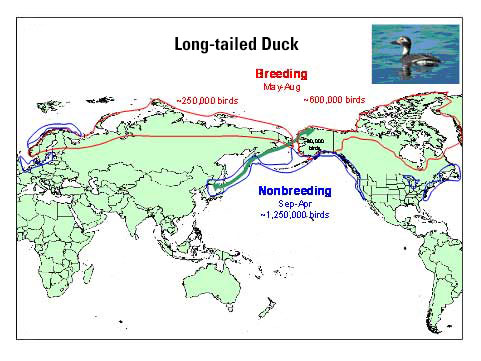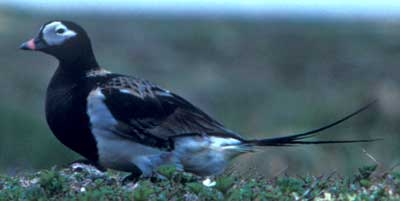Long-tailed Duck, Clangula hyemalis
High-Priority Species ListPrevious work on virus exposure (not avian influenza) of molting Long-tailed Ducks showed substantial variation in prevalence among flocks and locations (Hollmén et al. 2003). Thus, it seems clear that birds within flocks are not independent from the standpoint of virus exposure. During the flightless molt, flocks of birds are functionally isolated within lagoons as large areas of unsuitable habitat separate flocks (Flint et al. 2004); however, exchange of individuals prior to the molt likely creates a positive correlation in exposure probability within lagoons. Thus, a sampling strategy spread relatively uniformly across the molting range is the most effective sampling strategy for birds molting in clumped distributions.
Sampling locations: Primary locations in order of priority include Flaxman/Maguire Islands, Simpson Lagoon, and the coast of the Arctic NWR. Secondary locations, within these lagoons, will be determined based on observed flock locations and movement patterns.
Sampling timeframe: Late July through early August.
Sample demographics: After-hatch-year males and females. The sample will be primarily post-breeding males and both failed and non-breeding (likely sub-adult) females.
Methods of capture: Flocks of flightless birds will be herded with boats and driven into water-based corral traps. This approach has been used to capture Long-tailed Ducks in the Beaufort Sea lagoons in the past.
Other targeted species: None, flocks of Long-tailed Ducks rarely mix with other species.
Supplemental sampling: Small numbers of Long-tailed Ducks can be sampled in conjunction with other ongoing studies. Small numbers of nests are found during various studies on the Yukon-Kuskokwim Delta. Fecal samples can be obtained from many of these nests.
Contact: Richard Lanctot
Arctic NWR (Sampling along Refuge and near Flaxman and Maguire Islands)
Hollmén, T. E., J. C. Franson, P. L. Flint, J. B. Grand, R. B. Lanctot, D. E. Docherty, H. M. Wilson. 2003. An Adenovirus Linked to Mortality and Disease in Long-tailed Ducks (Clangula hyemalis) in Alaska. Avian Diseases 47:1434-1440.
Petersen, M. R., B. J. McCaffery, and P. L. Flint 2003. Postbreeding distribution of Long-tailed Ducks Clangula hyemalis from the Yukon-Kuskokwim Delta. Wildfowl 54: 129-139.

Ranking Score: 10.0
Asian H5N1 ranking criteria for Long-tailed Duck, Clangula hyemalis.
Total of partial contact with Asia1 |
Contact with known "hot spot"2 |
Habitat used in Asia3 |
Pop. in Alaska4 |
Can samples be obtained? |
Score |
2.0 |
1.0 |
2.0 |
3.0 |
2.0 |
10.0 |
Approx 250,000 breed in northeastern Russia, unknown numbers cross to North America |
No known use of AI-infected areas |
Nests coastal tundra; postbreeding use estuarine area |
Approx. 80,000 summer in western Alaska, 600,000 in northern Alaska and western Canada |
Samples could be obtained easily from fall birds |

